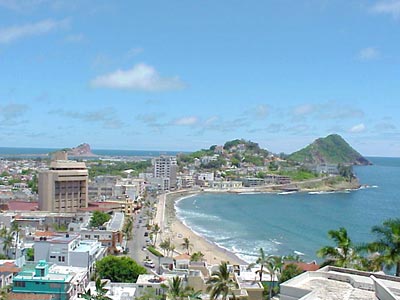Visitors and locals
scream, sing, shout and dance amid confetti and ribbons. Bands of
all kinds play the infectious rhythms of the State of Sinaloa. And
the food-oh, the food-camarones (shrimp) prepared in every way possible,
washed down with ice cold Pacifico beer, for it's Carnaval Time, Mazatlán's
biggest pachanga (fiesta). For seven miles, all along the beachfront
Malecón, beginning at Paseo de las Olas Altas, the festivities
have been attracting celebrants for over 100 years.
People arrive from all over Mexico and abroad for Carnaval, Mazatlán's
celebration of Mardi Gras. Said to be the third largest in the world
after those in New Orleans and Rio de Janeiro, Carnaval is this Pacific
resort city's most attended annual event, attracting as many as 300,000-400,000
revelers. Since 1897, it has been traditionally held the week before
Lent.
Like
its big sisters in New Orleans and Rio, the celebration offers parades,
special shows, and the coronation of La Reina de Carnaval, Queen of
Carnaval. The "Carnavaldome" on Avenida. del Mar on Playa
Norte, north of town, is the primary focus of the street action. This
temporary assortment of stages and booths features continuous music--tropicale,
mariachi, rock, and norteña--food vendors, outrageous costume-wearing,
and all-night dancing throughout the festival.
Avenida
del Mar is also the site of two fireworks displays, the traditional
castillo--a castle-like fireworks platform unique to Mexico-on Saturday
night, and an offshore fireworks finale representing a mock naval battle,
in commemoration of Mazatlán's 1864 victory over the French Navy,
on Sunday night.
The
main events kick off the Friday evening before Shrove Tuesday with the
juegos florales, or "floral games" in the city baseball stadium.
During this well-attended event, a Flower Queen is crowned and literary
awards are bestowed upon contestants who have written the best "flowery
verse." Top prize is the prestigious Clemencia Isaura Poetry Award,
a 68-year tradition that honors the best unpublished work from anywhere
in Mexico.
|
|

|
Saturday
evening activities begin with the coronation of the Carnaval Queen and
El Rey Feo, or "Ugly King" at the Estadio Teodoro Mariscal
an event that usually includes concert performances by major Latin artists.
This is followed by the Quema de Mal Humor, or "Burning of Bad
Humor," in which an effigy, usually modeled after an unpopular
politician of the day, is hanged and burned. Sunday is the biggest Camavaldome
night, while the Monday following the weekend is El Día del Marido
Oprimido the "Day of the Oppressed Husband," in which married
men are to be allowed 23 ½ hours of freedom to do whatever they
wish.
Two
large costume parades, one on Sunday at 6 p.m. and the other on Tuesday
at 4 p.m., feature dozens of floats representing various mythological
figures from Aladdin to Zeus, plus the newly crowned Carnaval "royalty."
Originally, spectators threw rocks and sticks at the floats, and then
switched to seashells. But with the apparent danger to the float riders,
the town fathers ruled that now only confetti should be thrown. Tambora
sinaloense bands come from all around the state to participate in the
parades, which may feature as many as 10 tambora ensembles per day.
And
every night from Thursday to Tuesday, music fills the Malecón
(ocean-side promenade) running along Olas Altas Beach downtown. Roving
mariachi bands, the local traditional bandas sinaloenses with lots of
brass, and rock bands set up along the way provide plenty of entertainment
for the happy, milling crowd, which increases each day until Tuesday
night when the Malecón is packed with musicians, dancers and
those seeking a good time.
At
the turn of the century, Plazuela Machado was the central focus of Carnaval.
Now that the plaza area is the center of Mazatlán's downtown
restoration, Carnaval activities have returned once again, but this
time with a gastronomic fair held every evening Friday through Tuesday.
Prominent dishes on hand include Mazatlán's famous pescado zarandeado
(barbecued fish), camarones con mango (mango shrimp) and marlín
ahumada (smoked marlin) and lots of ice cold Pacifico beer.

